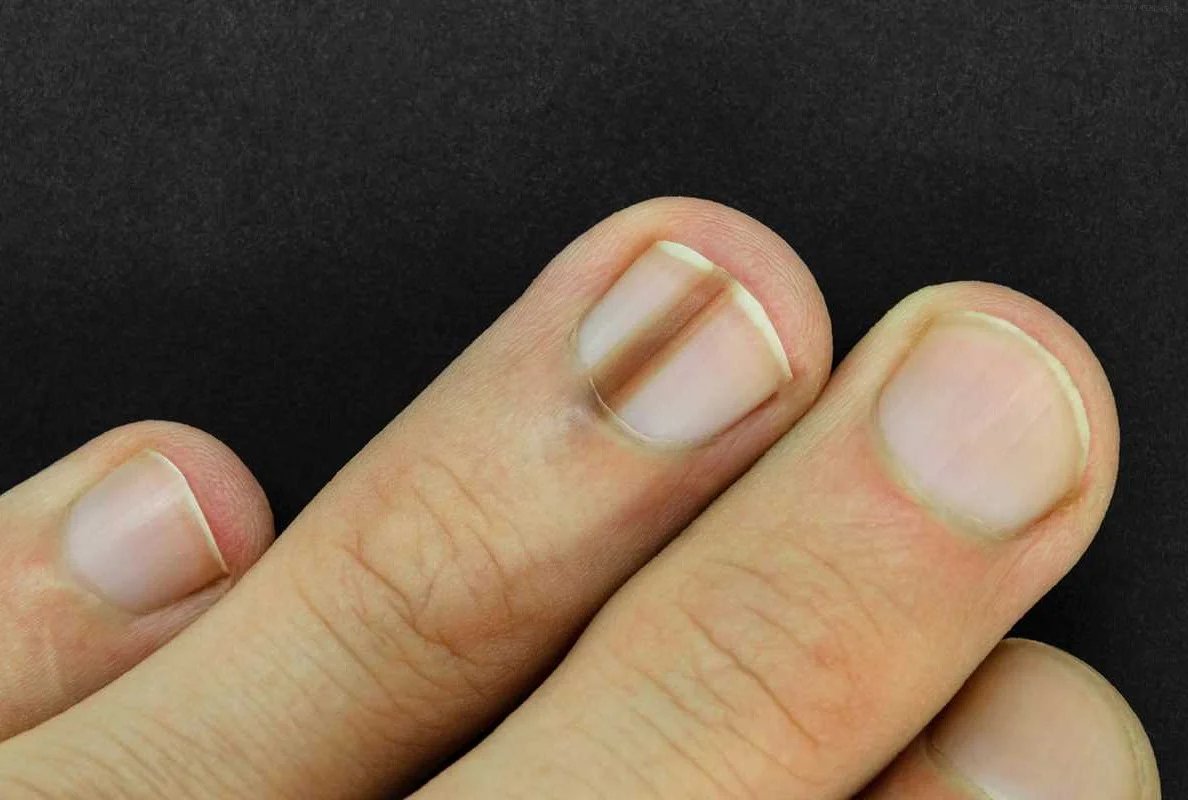What Nails Say About Human Health: The Doctor Named 12 Warning Signs
Discover what your nails can reveal about your overall health. From discoloration to ridges, learn about 12 warning signs that may indicate underlying health issues.
Our nails are not just a canvas for manicures, they can also provide valuable insights into our overall health. In fact, changes in the appearance and texture of our nails can be early warning signs of underlying health conditions. Driven by curiosity and the desire to help people, one doctor has identified 12 nail abnormalities that can indicate potential health problems.
1. Yellow nails: While some discoloration may be caused by nail polish or smoking, persistent yellow nails can be a sign of fungal infection or psoriasis. It can also indicate a respiratory condition such as chronic bronchitis.
2. Brittle nails: Brittle nails that easily break or peel can be a result of nutritional deficiencies, such as low levels of iron or biotin. They can also be a symptom of an underactive thyroid or an autoimmune disease like lupus.
3. White spots: Small white spots or lines on the nails are usually harmless and caused by minor injuries. However, if you notice an increase in their frequency or size, it could be a sign of a fungal infection or a zinc deficiency.
4. Spoon-shaped nails: Nails that have a concave shape or appear spoon-like can be an indication of iron deficiency anemia. This condition affects the body’s ability to produce healthy red blood cells.
5. Pitting: Small depressions or pitted nails can be a sign of psoriasis, a chronic autoimmune condition that affects the skin and joints. These pits are caused by abnormal growth of cells in the nail’s matrix.
6. Clubbing: Clubbing refers to the enlargement and rounding of the fingertips, along with an increased angle between the nail and the finger. It can be a sign of lung or heart disease, as well as other underlying health conditions that affect oxygen levels in the blood.
7. Horizontal ridges: Deep ridges that run horizontally across the nails, known as Beau’s lines, can indicate a severe illness or a stressful event that temporarily interrupted nail growth. These ridges can be a result of chemotherapy, uncontrolled diabetes, or even serious infections.
8. Vertical ridges: Vertical ridges are a natural part of aging and are usually harmless. However, if they become more prominent or are accompanied by other symptoms, they could be a sign of nutrient deficiencies or autoimmune disorders.
9. Nail clubbing: Nail clubbing refers to the thickening of the fingertips and rounding of the nails. It can be a sign of various lung diseases, including lung cancer and chronic obstructive pulmonary disease (COPD).
10. Nail separation: When nails separate from the nail bed, it can be a sign of psoriasis, thyroid disease, or a fungal infection. In some cases, it may also indicate a reaction to certain medications.
11. Blue nails: Bluish discoloration of the nails can be a sign of poor circulation or a lack of oxygen in the blood. It can be associated with lung or heart problems, as well as certain medications.
12. Beau’s lines: Beau’s lines are horizontal grooves or depressions in the nails that can be caused by severe illness, malnutrition, or physical trauma. They can appear after a major surgery, a high fever, or chemotherapy.
In conclusion, our nails can serve as a window into our overall health. Paying attention to any changes in their appearance or texture can help identify potential health problems early on. If you notice any of these warning signs, it’s important to consult with a healthcare professional for proper diagnosis and treatment.
Pale Nails: Possible Indication of Anemia or Malnutrition

Pale nails are a common sign that something may be amiss with your health. When your nails appear pale or have a washed-out appearance, it could be an indication of an underlying condition such as anemia or malnutrition.
Anemia occurs when your body lacks enough healthy red blood cells to carry adequate oxygen to your tissues. This can result in a pale or white appearance in your nails, as the reduced oxygen levels affect the blood flow to the nail bed.
Malnutrition, on the other hand, can also lead to pale nails. When your body doesn’t receive the necessary nutrients, it can affect the growth and health of your nails. This can manifest as a paleness in the nails.
It’s important to note that pale nails alone are not a definitive diagnosis of anemia or malnutrition. Other symptoms and medical tests may be required to confirm the underlying cause. If you notice your nails appearing pale, it may be worth discussing with a healthcare professional to determine the appropriate course of action.
If you suspect anemia or malnutrition, it’s important to address the root cause and seek appropriate medical treatment. A healthcare professional can help identify any nutritional deficiencies and create a plan to improve your overall health.
In summary, pale nails can be a possible indication of anemia or malnutrition. Paying attention to changes in your nail color can provide valuable insights into your health and prompt you to seek necessary medical attention if needed.
Yellow Nails: Potential Sign of Fungal Infection or Thyroid Disease
Yellow nails can be a potential sign of an underlying health issue, such as a fungal infection or thyroid disease. While yellowing of the nails can sometimes be attributed to factors like smoking or the use of dark nail polish, persistent yellowing can indicate a more serious problem.
A fungal infection, specifically onychomycosis, is a common cause of yellow nails. This condition occurs when fungus enters the nail bed and begins to grow, causing discoloration, thickening, and a change in texture. The affected nails may also become brittle and crumbly.
Thyroid disease, including conditions like hypothyroidism or hyperthyroidism, can also manifest as yellow nails. Thyroid hormones play a significant role in regulating the health of nails, hair, and skin. Changes in nail color, such as yellowing, can be indicative of an imbalance in thyroid function.
If you notice that your nails are consistently yellow, it is important to consult a healthcare professional for a proper diagnosis. They will be able to assess your symptoms, conduct any necessary tests, and provide appropriate treatment options.
In the case of a fungal infection, antifungal medications or topical treatments may be prescribed. For thyroid-related yellowing, addressing the underlying thyroid condition through medication or lifestyle changes may help improve nail health.
Remember, yellow nails can be a potential warning sign, so it is important to seek medical attention to determine the root cause and ensure proper treatment.
Blue Nails: Could Indicate Poor Circulation or Lung Problems
Blue nails, also known as cyanosis, can be a warning sign of poor circulation or lung problems. When the nails appear bluish, it is often a result of the lack of oxygen in the blood. This can be due to various reasons, such as heart or lung disease, asthma, or even exposure to cold temperatures.
If you notice that your nails have a bluish tinge, it is important to pay attention to other symptoms that may accompany this condition, such as shortness of breath, chest pain, or fatigue. These symptoms can help determine the underlying cause of the blue nails.
Poor circulation, also known as peripheral vascular disease, can cause a lack of oxygenated blood to reach the extremities, including the nails. This can result in a bluish coloration of the nails. It is often associated with conditions like diabetes, high blood pressure, or high cholesterol.
Lung problems, such as chronic obstructive pulmonary disease (COPD) or pulmonary fibrosis, can also lead to blue nails. These conditions affect the lungs’ ability to provide enough oxygen to the blood, causing cyanosis in the nails.
If you notice that your nails are consistently blue or if you have any other concerning symptoms, it is important to consult a healthcare professional. They can perform a thorough examination and conduct additional tests to determine the underlying cause of the blue nails and provide appropriate treatment.
White Spots on Nails: Potential Sign of Mineral Deficiency or Injury

White spots on nails, also known as leukonychia, can be a potential sign of mineral deficiency or injury. While they may seem harmless, they can indicate underlying health issues that should not be ignored.
The appearance of white spots on nails can be caused by various factors. One common cause is a mineral deficiency, particularly a lack of zinc or calcium in the body. These essential minerals play a crucial role in maintaining the health and strength of the nails. A deficiency can lead to weakened nails that are prone to developing white spots.
In addition to mineral deficiencies, white spots on nails can also be a result of physical trauma or injury to the nail bed. The trauma can cause damage to the nail matrix, which is responsible for nail growth. This damage can manifest as white spots on the nail surface.
It is important to note that not all white spots on nails are a cause for concern. In some cases, they may be harmless and temporary, such as due to mild trauma or minor nutritional imbalances. However, if the white spots persist or are accompanied by other nail abnormalities, it is recommended to consult a healthcare professional.
When evaluating white spots on nails, healthcare providers may consider other symptoms and conduct further tests to determine the underlying cause. This may involve blood tests to check for mineral deficiencies or imaging studies to assess the extent of any nail bed injuries.
To maintain healthy nails and potentially prevent the occurrence of white spots, it is important to ensure a balanced diet that includes an adequate intake of essential minerals. Additionally, protecting the nails from trauma and injury can help prevent the development of white spots.
In conclusion, white spots on nails can be a potential sign of mineral deficiency or nail bed injury. While not always a cause for alarm, it is important to monitor their appearance and consult a healthcare professional if they persist or are accompanied by other concerning symptoms. Taking steps to maintain a balanced diet and protect the nails can help promote overall nail health.